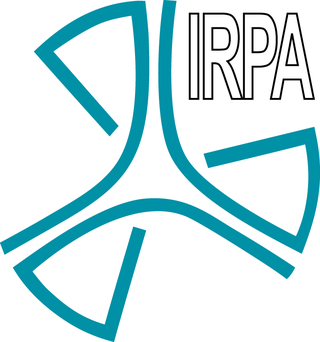Top Qs
Timeline
Chat
Perspective
International Radiation Protection Association
From Wikipedia, the free encyclopedia
Remove ads
The International Radiation Protection Association (IRPA) is an independent non-profit association of national and regional radiation protection societies, and its mission is to advance radiation protection throughout the world. It is the international professional association for radiation protection.[1]
IRPA is recognized by the IAEA as a Non Governmental Organization (NGO) and is an observer on the IAEA Radiation Safety Standards Committee (RASSC).[2]
IRPA was formed on June 19, 1965, at a meeting in Los Angeles; stimulated by the desire of radiation protection professionals to have a world-wide body. Membership includes 50 Associate Societies covering 65 countries, totaling approximately 18,000 individual members.[3][4]

Remove ads
Structure
The General Assembly, made up of representatives from the Associate Societies, is the representative body of the Association. It delegates authority to the Executive Council for the efficient administration of the affairs of the Association.
Specific duties are carried out by IRPA Commissions, Committees, Task Groups and Working Groups:
- Commission on Publications
- Societies Admission and Development Committee
- International Congress Organising Committee
- International Congress Programme Committee
- Montreal Fund Committee
- Radiation Protection Strategy and Practice Committee
- Regional Congresses Co-ordinating Committee
- Rules Committee
- Sievert Award Committee
- Task Group on Security of Radioactive Sources
- Task Group on Public Understanding of Radiation Risk
- Working Group on Radiation Protection Certification and Qualification
Remove ads
Associate societies
Summarize
Perspective
The following is a list of the 50 Associate Societies (covering 65 countries):
Remove ads
List of International Congresses
The 2032 Congress (IRPA18) will be in Australia.
The 2028 Congress (IRPA17) will be in Spain.
Past Congresses
IRPA 16 Orlando, July 2024
IRPA 15 Seoul, January 2021
IRPA 14 Cape Town, May 2016
IRPA 13 Glasgow, May 2012
IRPA 12 Buenos Aires, October 2008
IRPA 11 Madrid, May 2004
IRPA 10 Hiroshima, May 2000
IRPA 9 Vienna, April 1996
IRPA 8 Montreal, May 1992
IRPA 7 Sydney, April 1988
IRPA 6 Berlin, May 1984
IRPA 5 Jerusalem, March 1980
IRPA 4 Paris, April 1977
IRPA 3 Washington, September 1973
IRPA 2 Brighton, May 1970
IRPA 1 Rome, September 1966
International Cooperation
IRPA maintains relations with many other international organizations in the field of radiation protection, such as those listed here.
Inter-Governmental Organizations
Non-Governmental Organizations
Professional Organizations
| IOMP - International Organization for Medical Physics |
| ISR - International Society of Radiology |
| ISRO - International Society for Radiation Oncology |
| WFNMB - World Federation of Nuclear Medicine and Biology |
Remove ads
Awards
Summarize
Perspective
Rolf M. Sievert Award
Commencing with the 1973 IRPA Congress, each International Congress has been opened by the Sievert Lecture which is presented by the winner of the Sievert Award. This award is in honour of Rolf M. Sievert, a pioneer in radiation physics and radiation protection.
The Sievert Award consists of a suitable scroll, certificate or parchment, containing the name of the recipient, the date it is presented, and an indication that the award honours the memory of Professor Rolf M. Sievert.
The recipients of the Sievert Award are listed below:[7]
- 1962: W Binks & Karl Z. Morgan
- 1965: William Valentine Mayneord (United Kingdom), The Time Factor in Carcinogenesis Health Physics 34 (April), pp 297–309, 1978
- 1973: Lauriston S. Taylor (USA), Some Nonscientific Influences on Radiation Protection Standards and Practice Health Physics 39 (December), pp 851–874, 1980
- 1981: sir Edward E. Pochin (United Kingdom), Sieverts and Safety Health Physics 46(6), pp 1173–1179, 1984
- 1985: Shinji Takahashi[8]
- 1989: Bo Lindell (Sweden), Radiation and Man Health Physics 31 (September), pp 265–272, 1976
- 1993: Itsuzo Shigematsu (Japan), Lessons from Atomic Bomb Survivors in Hiroshima and Nagasaki Health Physics 78(3), pp 234–241, 2000
- 2000: Angelina Guskova
- 2004: Richard Doll
- 2008: K Sankaranarayanan
- 2012: Keith Eckerman
- 2016: Ethel Gilbert
- 2020: Dale Preston
Remove ads
See also
- Radioactivity
- Ionizing radiation
- Radiation protection
- International Atomic Energy Agency (IAEA)
- International Commission on Radiological Protection (ICRP)
- United Nations Scientific Committee on the Effects of Atomic Radiation (UNSCEAR)
- International Commission on Non-Ionizing Radiation Protection (ICNIRP)
- Index of radiation articles
References
External links
Wikiwand - on
Seamless Wikipedia browsing. On steroids.
Remove ads

